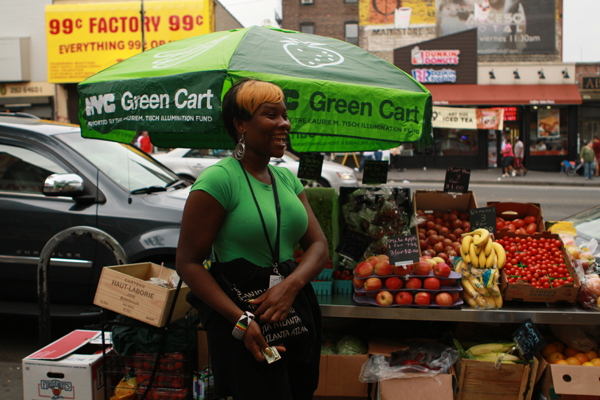A New York City Green Cart vendor (photo: Marc Shavitz)
When New York City launched its Green Cart Initiative in 2008, residents in low-income areas were suffering disproportionately from obesity and diet-related disease, while these same neighborhoods lacked sufficient access to retailers selling fresh fruits and vegetables. According to a 2008 study by the City's Department of Health and Mental Hygiene (DOHMH) and the Department of Planning, approximately three million New Yorkers lived in neighborhoods with few grocery stores and high rates of diabetes and obesity.
Challenged by this public health crisis, Mayor Bloomberg's Office of Food Policy decided to focus on increasing access to healthy food in these specific local communities, which are sometimes referred to as "food deserts." Food deserts are areas of the city where access to fresh food outlets is limited and where consumption of fruits and vegetables is particularly low. The public policy bet was simple: increasing access would, in theory, increase consumption and, in the long-term, improve public health. The Green Cart program was implemented by the Mayor's Office of Food Policy and the City DOHMH in partnership with the Laurie M. Tisch Illumination Fund as part of a broader citywide food access strategy.
In mid-2013, after six years in operation, the Laurie M. Tisch Illumination Fund engaged Columbia University, SIPA to independently determine if Green Carts was meeting its goals.
We focused our analysis on 1) assessing the effectiveness of Green Carts in improving access to fresh fruits and vegetables for low-income New Yorkers; 2) assessing the economic viability of Green Carts as small businesses; 3) determining whether Green Carts is changing customer behavior; and 4) examining the role of philanthropy in promoting and supporting innovative public policy. As baseline data was not available, our research team spent three months (July – September 2013) locating and interviewing (in Bengali, Spanish and English) Green Carts vendors and their customers to collect extensive primary data on vendor location and neighborhood characteristics; cart locations, vendor demographics and business practices; and customer demographics, purchasing behavior and consumption behavior. Key findings of the report indicate that the NYC Green Cart initiative has been an extraordinary success. Green Carts is achieving the following:
Increasing access to fresh produce in targeted neighborhoods. We located 166 Green Carts operating across four boroughs during peak vending season. The DOHMH has subsequently released data that it observed and inspected 329 unique permitted Green Carts operating during a twelve month period. As an added benefit, the DOHMH also recently found an increase in produce in small grocery stores and bodegas in green cart zones.
Reaching the low-income populations in neighborhoods exhibiting characteristics associated with "food deserts." Green Carts are all located in neighborhoods with high rates of diet-related diseases and high rates of poverty. According to a spatial analysis, most Green Carts are located in areas with relatively low produce store density, indicating that Green Carts is achieving its goal of reaching communities with unmet needs. Moreover, 68 percent of customers earn less than $50,000 per year, close to the federal guideline for a family of four living at 200 percent of poverty.
Changing customer behavior, with customers reporting regular visits and increased consumption of fresh fruits and vegetables. 71 percent of customers surveyed reported increased consumption of fresh fruits and vegetables since shopping at a Green Cart, and 63 percent of customers are "regular" shoppers (at least once a week).
Providing entrepreneurial opportunities to vendors. Green Carts is economically viable in the long-term. 80 percent of vendors consider themselves "very profitable" or "somewhat profitable." 50 percent of vendors have been vending more than two years; 75 percent of vendors believe their experience running a Green Cart will help them open a larger business.
While the NYC Green Cart initiative has achieved unprecedented success, we also identified several opportunities that we hope can enhance the program in the future and be useful to other cities adopting the model:
- The market-based approach, allowing vendors to locate anywhere within the designated zone, does not evenly distribute vendors across the designated high-need areas. Vendors who succeed economically are choosing locations with high foot traffic, near bodegas and near bus stops. Incentives could be given to vendors to move into locations which have greater economic risk.
- Vendors are locating close to public housing in only one borough. This suggests that there may be more opportunities to reach high-need populations through a partnership with NYCHA.
- There is inadequate tracking of operational Green Carts and no way to identify exact vendor locations or which vendors are actually operating their carts. Improved tracking and a market analysis would help to determine the appropriate number of vendors for each targeted neighborhood.
We also found that the public-private partnership model was critical to the success of the Green Carts Initiative. The Illumination Fund's initial grant enabled the City to implement an innovative program, and as the program progressed, it provided additional supports that government was unable to fund. Certainly, there are many ways to improve the program, as our research indicates. The overall findings are, however, very clear: Green Carts has been a success for both vendors and customers in underserved low-income communities and is a model program for densely populated urban areas across the United States
***
Ester R. Fuchs, Professor of International and Public Affairs and Political Science, Columbia University School of International and Public Affairs
Do you have an op-ed idea or submission for Gotham Gazette? Send it to Executive Editor Ben Max: This email address is being protected from spambots. You need JavaScript enabled to view it.
